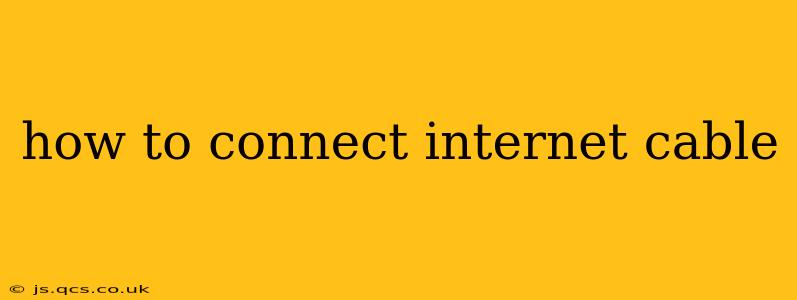Connecting your internet cable might seem straightforward, but there are a few nuances to ensure a stable and fast connection. This guide will walk you through the process, addressing common questions and potential issues along the way.
What Type of Internet Cable Do I Have?
Before you begin, identify the type of cable you're using. The most common are coaxial cables (often used with cable internet) and Ethernet cables (used with DSL, fiber, or cable internet). Coaxial cables are thicker and have a single central conductor surrounded by shielding, while Ethernet cables are typically thinner and have multiple pairs of wires. Knowing the type helps ensure you connect it to the correct port.
How to Connect a Coaxial Cable
Coaxial cables are frequently used for cable internet. Here's how to connect one:
- Locate the wall outlet: This is usually a small, rectangular box with a single coaxial port.
- Locate the modem's coaxial input: Your modem will have a port that looks like a small, threaded hole, often labeled "Cable In" or with a cable TV symbol.
- Connect the cable: Screw the coaxial cable firmly into both the wall outlet and the modem's input port. Ensure it's securely fastened; a loose connection can lead to signal problems.
How to Connect an Ethernet Cable
Ethernet cables provide a more stable and often faster connection than coaxial cables. Here's the process:
- Locate the wall outlet or modem port: You might have an Ethernet port on your wall (often labeled with an Ethernet symbol) or directly on your modem.
- Locate the device's Ethernet port: Your computer, router, or other device will have one or more Ethernet ports, typically looking like a rectangular slot.
- Connect the cable: Plug one end of the Ethernet cable firmly into the wall outlet or modem port and the other end into the device's Ethernet port. The connection should feel secure.
What if My Internet Still Doesn't Work?
Several factors can cause internet connectivity issues even after correctly connecting the cable. Let's address some common problems:
My internet is slow.
Slow internet speed can stem from several sources. A weak signal from your provider, network congestion, or interference are all possibilities. Try restarting your modem and router. Check if other devices are using a lot of bandwidth. Consider upgrading your internet plan if consistently slow speeds are a problem.
My internet keeps disconnecting.
Intermittent disconnections could indicate a loose cable connection, a faulty cable, or problems with your internet service provider. Check all cable connections, and try a different cable if possible. Contact your ISP if the issue persists.
I can't find the right port.
If you're unsure which port to use, consult your modem or router's manual. Pictures are usually provided to show cable and Ethernet port locations.
What if my internet cable is damaged?
A damaged cable is a frequent cause of connectivity problems. Look for obvious signs of damage like kinks, cuts, or exposed wires. If your cable is damaged, you'll need a replacement.
My router is not connecting to the internet.
Ensure the router is correctly connected to the modem with either a coaxial or Ethernet cable (depending on your setup). The router itself might need a power cycle (unplug it, wait 30 seconds, and plug it back in) or a factory reset. Also, check the router's configuration to ensure it is correctly set up for your internet service.
By following these steps and addressing potential issues, you can ensure a successful internet cable connection and enjoy a reliable internet experience. Remember to consult your internet service provider's support documentation or contact them if you continue to experience problems.
